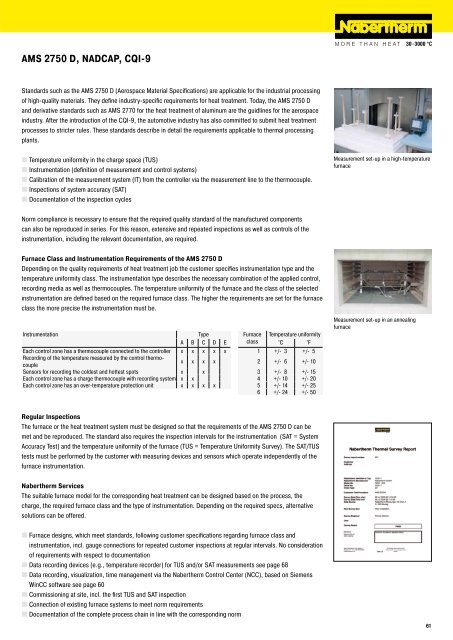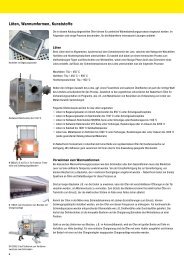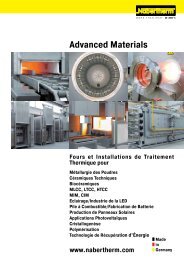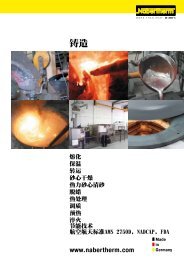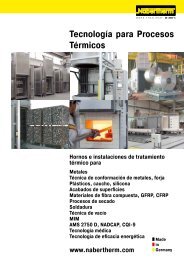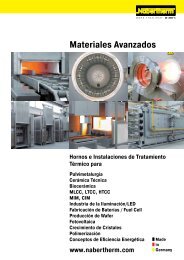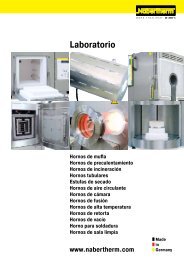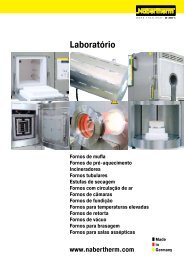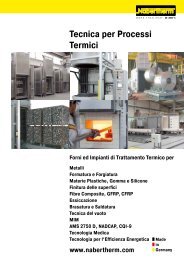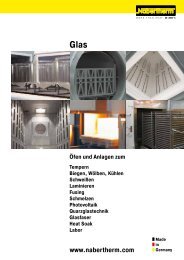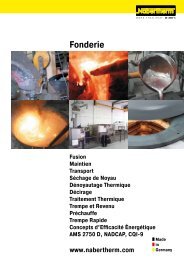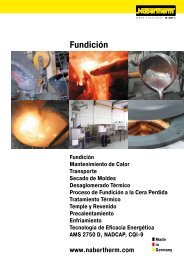AMS 2750 D, NADCAP, CQI-9
AMS 2750 D, NADCAP, CQI-9
AMS 2750 D, NADCAP, CQI-9
You also want an ePaper? Increase the reach of your titles
YUMPU automatically turns print PDFs into web optimized ePapers that Google loves.
<strong>AMS</strong> <strong>2750</strong> D, <strong>NADCAP</strong>, <strong>CQI</strong>-9<br />
Standards such as the <strong>AMS</strong> <strong>2750</strong> D (Aerospace Material Specifications) are applicable for the industrial processing<br />
of high-quality materials. They define industry-specific requirements for heat treatment. Today, the <strong>AMS</strong> <strong>2750</strong> D<br />
and derivative standards such as <strong>AMS</strong> 2770 for the heat treatment of aluminum are the guidlines for the aerospace<br />
industry. After the introduction of the <strong>CQI</strong>-9, the automotive industry has also committed to submit heat treatment<br />
processes to stricter rules. These standards describe in detail the requirements applicable to thermal processing<br />
plants.<br />
Temperature uniformity in the charge space (TUS)<br />
Instrumentation (definition of measurement and control systems)<br />
Calibration of the measurement system (IT) from the controller via the measurement line to the thermocouple.<br />
Inspections of system accuracy (SAT)<br />
Documentation of the inspection cycles<br />
Norm compliance is necessary to ensure that the required quality standard of the manufactured components<br />
can also be reproduced in series. For this reason, extensive and repeated inspections as well as controls of the<br />
instrumentation, including the relevant documentation, are required.<br />
Furnace Class and Instrumentation Requirements of the <strong>AMS</strong> <strong>2750</strong> D<br />
Depending on the quality requirements of heat treatment job the customer specifies instrumentation type and the<br />
temperature uniformity class. The instrumentation type describes the necessary combination of the applied control,<br />
recording media as well as thermocouples. The temperature uniformity of the furnace and the class of the selected<br />
instrumentation are defined based on the required furnace class. The higher the requirements are set for the furnace<br />
class the more precise the instrumentation must be.<br />
Instrumentation Type Furnace Temperature uniformity<br />
A B C D E class °C °F<br />
Each control zone has a thermocouple connected to the controller x x x x x 1 +/- 3 +/- 5<br />
Recording of the temperature measured by the control thermocouple<br />
x x x x 2 +/- 6 +/- 10<br />
Sensors for recording the coldest and hottest spots x x 3 +/- 8 +/- 15<br />
Each control zone has a charge thermocouple with recording system x x 4 +/- 10 +/- 20<br />
Each control zone has an over-temperature protection unit x x x x 5 +/- 14 +/- 25<br />
6 +/- 24 +/- 50<br />
Regular Inspections<br />
The furnace or the heat treatment system must be designed so that the requirements of the <strong>AMS</strong> <strong>2750</strong> D can be<br />
met and be reproduced. The standard also requires the inspection intervals for the instrumentation (SAT = System<br />
Accuracy Test) and the temperature uniformity of the furnace (TUS = Temperature Uniformity Survey). The SAT/TUS<br />
tests must be performed by the customer with measuring devices and sensors which operate independently of the<br />
furnace instrumentation.<br />
Nabertherm Services<br />
The suitable furnace model for the corresponding heat treatment can be designed based on the process, the<br />
charge, the required furnace class and the type of instrumentation. Depending on the required specs, alternative<br />
solutions can be offered.<br />
Furnace designs, which meet standards, following customer specifications regarding furnace class and<br />
instrumentation, incl. gauge connections for repeated customer inspections at regular intervals. No consideration<br />
of requirements with respect to documentation<br />
Data recording devices (e.g., temperature recorder) for TUS and/or SAT measurements see page 68<br />
Data recording, visualization, time management via the Nabertherm Control Center (NCC), based on Siemens<br />
WinCC software see page 60<br />
Commissioning at site, incl. the first TUS and SAT inspection<br />
Connection of existing furnace systems to meet norm requirements<br />
Documentation of the complete process chain in line with the corresponding norm<br />
Measurement set-up in a high-temperature<br />
furnace<br />
Measurement set-up in an annealing<br />
furnace<br />
61
<strong>AMS</strong> <strong>2750</strong> D, <strong>NADCAP</strong>, <strong>CQI</strong>-9<br />
62<br />
Implementation of <strong>AMS</strong> <strong>2750</strong> D<br />
Basically, two different systems are available for control and documentation, a proven Nabertherm system<br />
solution or instrumentation using Eurotherm controllers/temperature recorders. The Nabertherm <strong>AMS</strong> package is a<br />
convenient solution that includes the Nabertherm Control Center for control, visualization, and documentation of the<br />
processes and test requirements based on PLC control.<br />
Instrumentation with Nabertherm Control Center (NCC) for Control, Visualization, and Documentation<br />
based on a Siemens PLC Controls<br />
The attractive feature of the instrumentation with Nabertherm Control Center in combination with PLC controls of the<br />
furnace is the convenient data input and visualization. The software programming is structured in a way that both the<br />
user and the auditor can navigate it without difficulty.<br />
In daily use, the following product characteristics stand out:<br />
Very easy to navigate and straight-forward presentation of all the data in plain text on the PC<br />
Automatic saving of the charge documentation at the end of the program<br />
Administration of the calibration cycles in the NCC<br />
Results of the measurement distance calibration are entered in the NCC<br />
Schedule management of the required testing cycles including a reminder function. The testing cycles for TUS<br />
(Temperature Uniformity Survey) and SAT (System Accuracy Test) are entered in days and monitored by the<br />
system and the operator or tester is informed in time about up-coming tests. The values of the tests are entered<br />
directly into NCC and saved as PDF files on the PC. There are no additional tasks involved in documenting the<br />
tests.<br />
Option of transferring the measurement data to a customer's server<br />
Furnace chamber<br />
Usable space<br />
Thermocouple for the<br />
highest temperature<br />
Over-temperature<br />
limiter<br />
Furnace<br />
Example of a design with Type A Nabertherm Control Center<br />
Control thermocouple<br />
Charge thermocouple<br />
Thermocouple for the lowest<br />
temperature<br />
Nabertherm Control Center<br />
The Nabertherm Control Center can be extended to enable a complete documentation of the heat treatment<br />
process apart from just the furnace data. For example, when heat-treating aluminum, in addition to the furnace, the<br />
temperatures in the quenching basin or a separate cooling medium can also be documented.
Instrumentation for TUS Measurements as a Separate Model<br />
The TUS standard requires that the temperature uniformity of the furnace be tested with a TUS measurement at<br />
regular intervals. This measurement must be performed by an independent measurement system and not by the<br />
instrumentation used for process control. The testing intervals are filed in the NCC in days. The system reminds in<br />
time that a test must be performed.<br />
This test can be performed either using an independent temperature recorder (see page 64) with the customer's<br />
calibrated testing thermocouples or using the Nabertherm TUS module that is connected to the Nabertherm Control<br />
Center as a separate module.<br />
The TUS module has its own PLC which converts the measurement results of the testing thermocouples.<br />
The evaluation, including an easy-to-navigate and simply log function, is then performed via the furnace's<br />
Nabertherm Control Center.<br />
Over-temperature limiter<br />
Recorder Controller<br />
Controlling thermocouple<br />
Example of a design containing Type D Eurotherm instrumentation<br />
Furnace<br />
Alternative Instrumentation with Temperature Controllers and Recorders from Eurotherm<br />
As an alternative to instrumentation with the Nabertherm Control Center (NCC) and PLC controls,<br />
instrumentation with controllers and temperature recorders is also available. The temperature recorder has<br />
a log function that must be configured manually. The data can be saved to a USB stick and be evaluated,<br />
formatted, and printed on a separate PC. Besides the temperature recorder, which is integrated into the<br />
standard instrumentation, a separate recorder for the TUS measurements is needed (see page 64).<br />
TUS module with ports for 16 thermocouples<br />
and PROFIBUS connection to the<br />
Nabertherm Control Center<br />
N 12012/26 HAS1 according to <strong>AMS</strong> <strong>2750</strong> D<br />
63


